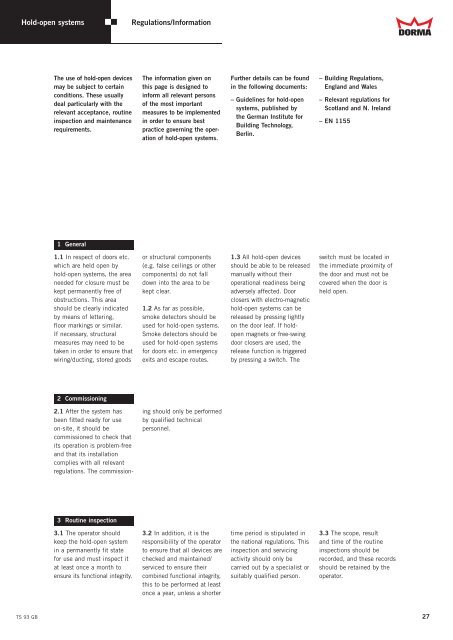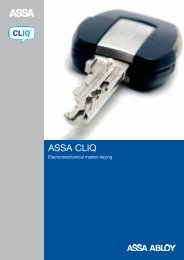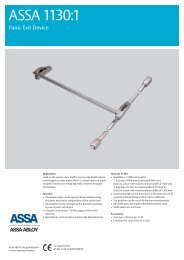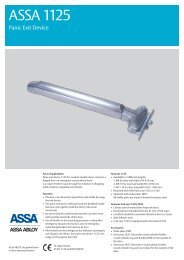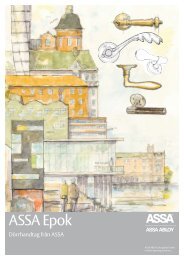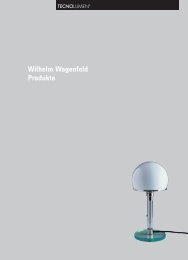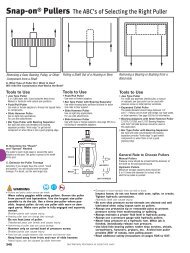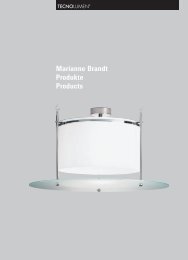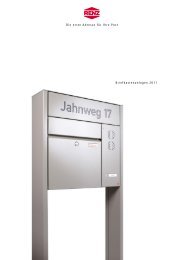TS 93 DORMA
TS 93 DORMA
TS 93 DORMA
Create successful ePaper yourself
Turn your PDF publications into a flip-book with our unique Google optimized e-Paper software.
Hold-open systems<br />
Regulations/Information<br />
The use of hold-open devices<br />
may be subject to certain<br />
conditions. These usually<br />
deal particularly with the<br />
relevant acceptance, routine<br />
inspection and maintenance<br />
requirements.<br />
The information given on<br />
this page is designed to<br />
inform all relevant persons<br />
of the most important<br />
measures to be implemented<br />
in order to ensure best<br />
practice governing the operation<br />
of hold-open systems.<br />
Further details can be found<br />
in the following documents:<br />
– Guidelines for hold-open<br />
systems, published by<br />
the German Institute for<br />
Building Technology,<br />
Berlin.<br />
– Building Regulations,<br />
England and Wales<br />
– Relevant regulations for<br />
Scotland and N. Ireland<br />
– EN 1155<br />
1 General<br />
1.1 In respect of doors etc.<br />
which are held open by<br />
hold-open systems, the area<br />
needed for closure must be<br />
kept permanently free of<br />
obstructions. This area<br />
should be clearly indicated<br />
by means of lettering,<br />
floor markings or similar.<br />
If necessary, structural<br />
measures may need to be<br />
taken in order to ensure that<br />
wiring/ducting, stored goods<br />
or structural components<br />
(e.g. false ceilings or other<br />
components) do not fall<br />
down into the area to be<br />
kept clear.<br />
1.2 As far as possible,<br />
smoke detectors should be<br />
used for hold-open systems.<br />
Smoke detectors should be<br />
used for hold-open systems<br />
for doors etc. in emergency<br />
exits and escape routes.<br />
1.3 All hold-open devices<br />
should be able to be released<br />
manually without their<br />
operational readiness being<br />
adversely affected. Door<br />
closers with electro-magnetic<br />
hold-open systems can be<br />
released by pressing lightly<br />
on the door leaf. If holdopen<br />
magnets or free-swing<br />
door closers are used, the<br />
release function is triggered<br />
by pressing a switch. The<br />
switch must be located in<br />
the immediate proximity of<br />
the door and must not be<br />
covered when the door is<br />
held open.<br />
2 Commissioning<br />
2.1 After the system has<br />
been fitted ready for use<br />
on-site, it should be<br />
commissioned to check that<br />
its operation is problem-free<br />
and that its installation<br />
complies with all relevant<br />
regulations. The commissioning<br />
should only be performed<br />
by qualified technical<br />
personnel.<br />
3 Routine inspection<br />
3.1 The operator should<br />
keep the hold-open system<br />
in a permanently fit state<br />
for use and must inspect it<br />
at least once a month to<br />
ensure its functional integrity.<br />
3.2 In addition, it is the<br />
responsibility of the operator<br />
to ensure that all devices are<br />
checked and maintained/<br />
serviced to ensure their<br />
combined functional integrity,<br />
this to be performed at least<br />
once a year, unless a shorter<br />
time period is stipulated in<br />
the national regulations. This<br />
inspection and servicing<br />
activity should only be<br />
carried out by a specialist or<br />
suitably qualified person.<br />
3.3 The scope, result<br />
and time of the routine<br />
inspections should be<br />
recorded, and these records<br />
should be retained by the<br />
operator.<br />
<strong>TS</strong> <strong>93</strong> GB<br />
27


